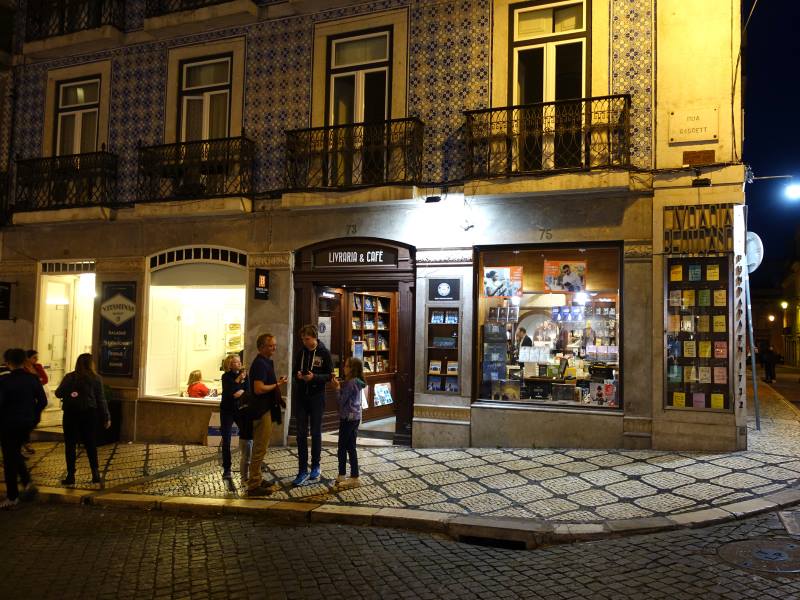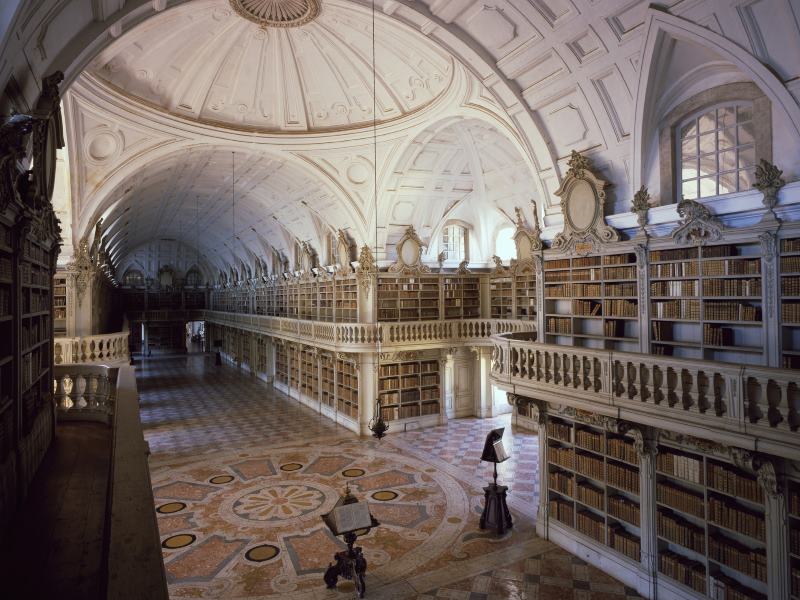
By Jill Fernandes
Travel Writer15 Jun 2020 - 6 Minute Read
Fiercely still, the stale air sent a shiver down my spine. A vacant armchair with blue velveteen cushions rocked back and forth. The door creaked shut, blocking the last streams of natural light from entering the library.
My travel companion, Amanda, and I were deep in the library of the Palácio Nacional de Mafra near Lisbon, in the upstairs Poetry section. An old book, looking long untouched, poked out from the shelf. I drew it out carefully. Suddenly, an almost inaudible, high-pitch squeal interrupted us. A dense, grey fog began seeping under the heavy oak door. I stood still and watched this mysterious development. Amanda whispered in a panic, “They’re coming for the books!”
* * * * *
Days earlier, we’d visited the exquisite Palácio Nacional de Mafra, 25mi (40km) northwest of Lisbon. Portugal is perhaps best known for its Port wine and golden beaches, but the Portuguese people are also hopelessly in love with literature. Literature was my long-lost love, so I followed it to where it would lead me.
On my travels in Lisbon, I stumbled into the Livraria Bertrand, established 1732, the world’s oldest bookshop still in operation. In Porto, I queued twice to see the architectural beauty of the Livraria Lello, an inspiration to JK Rowling when she wrote Harry Potter and the Philosopher's Stone. I even went in search of the home of Hans Christian Andersen, the Danish fairy tale author, who spent some time in the mystical land of Sintra. But my literary journey didn't stop there.

I continued on, this time to the Enlightenment Age – Coimbra's Biblioteca Joanina, a tri-chambered, dark wood and gold-rich masterpiece. Its heavy wooden doors and old manuscripts retained a musty smell. I could feel the lingering spirit of intellectuals and scholars, who had spent many hours at work in these chambers. Joanina houses books as old as the 15th century. I wondered how they preserved these delicate books for centuries.
This question brought me to the library of the National Palace of Mafra. We drove to Mafra Palace specifically to see the library, one of the newest heritage sites in Portugal. On this bright Sunday morning, the facade of this Baroque-styled monument gleamed white and yellow. Entering the Royal Convent, I stumbled into a solemn Latin service. Lit candelabra lined the arches, their wax melting onto the marble floors.
We continued into the Palace, wandering through the royal rooms – all exquisite, but none as alluring to me as a library. Entering the library, we followed an unspoken code of silent reverence. The floor was made of pink, blue, and grey marble. Delicate chandeliers hung from the domed ceiling. The library's collection of 36,000 volumes lined the extravagant rocaille shelves.

“How old are these?” I asked the library guide. He answered, “The oldest is our 15th century collection, but they are at great risk of deterioration.”
The entire collection faced this threat. If anything loves to devour books more than the Portuguese, it’s moths. Feeding on book pulp, they slowly destroy the volumes. But the library has an unusual symbiosis – the books attract moths, and the moths attract bats. Thus the books are preserved, and the bats are fed. The Mafra library has two varieties of moth-eating bats: grey long-eared, and serotine. Together, they consume hundreds of bugs a night.
“And where are they now?” I asked.
“They usually hide behind the bookshelves.”
I absorbed this literary atmosphere. It brought back childhood dreams, aspirations that now gathered dust.
Predisposed to nocturnality myself, I felt a harmony with these creatures. In the stillness of night, I'm up, much like the bats, with books and food. It’s in these quiet, dead hours of night that I write.
Come nightfall, the bats would be at work in the library. Predisposed to nocturnality myself, I felt a harmony with these creatures. In the stillness of night, I'm up, much like the bats, with books and food. It’s in these quiet, dead hours of night that I write.
I've always wanted to capture stories, tragic and euphoric, on the stillness of paper. But the romance of this idea obscured the stark reality of writing. I felt conflicted between my love of storytelling and my inability to write. Did I just have writer’s block, or did I permanently lack inspiration?
* * * * *
The grey fog swelled.
The soft, squealing sounds continued. I ignored them, and read on.
Of the haunting in these chambers that night.
When the darkness of evil harmed the meek
The fog was now a dense vortex that surrounded us. From within, a pair of eyes stared at me.
It swirled, thunderous, like a tornado in flight.
I stared back. The piercing gaze was frightening, yet I couldn't look away. I began to see numerous pairs of eyes. Sinuous swirls, leathery wings, and a high-pitched hum – a swarm of grey long-ears. Involuntarily, as if hypnotized, I drifted into the vortex.
Suddenly I fell, and shrieked. A jarring silence ensued. I was lying on my bedroom floor. A few books were knocked off the nightstand. It was still dark. The bats – they were gone!
Instinctively, I reached for a pen.
Discover similar stories in
connection
Travel Writer
Jill is an aspiring writer and a winner of the World Nomad Travel Writing Scholarship 2019. Her love is for writing narratives with unusual plots and abstract endings.



No Comments